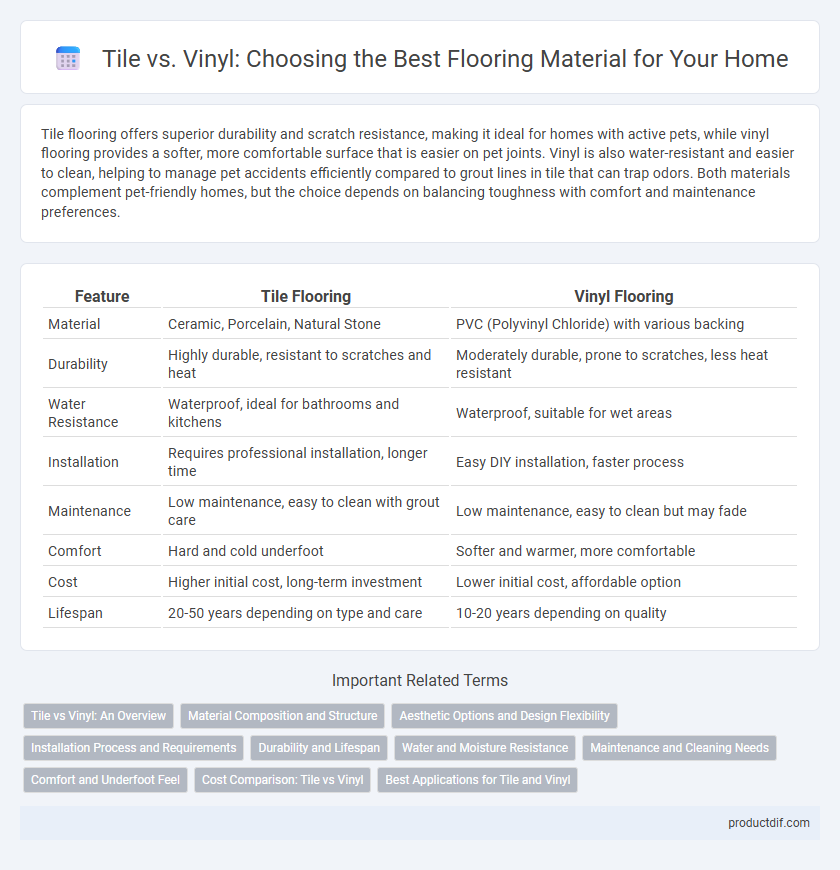Tile flooring offers superior durability and scratch resistance, making it ideal for homes with active pets, while vinyl flooring provides a softer, more comfortable surface that is easier on pet joints. Vinyl is also water-resistant and easier to clean, helping to manage pet accidents efficiently compared to grout lines in tile that can trap odors. Both materials complement pet-friendly homes, but the choice depends on balancing toughness with comfort and maintenance preferences.
Table of Comparison
| Feature | Tile Flooring | Vinyl Flooring |
|---|---|---|
| Material | Ceramic, Porcelain, Natural Stone | PVC (Polyvinyl Chloride) with various backing |
| Durability | Highly durable, resistant to scratches and heat | Moderately durable, prone to scratches, less heat resistant |
| Water Resistance | Waterproof, ideal for bathrooms and kitchens | Waterproof, suitable for wet areas |
| Installation | Requires professional installation, longer time | Easy DIY installation, faster process |
| Maintenance | Low maintenance, easy to clean with grout care | Low maintenance, easy to clean but may fade |
| Comfort | Hard and cold underfoot | Softer and warmer, more comfortable |
| Cost | Higher initial cost, long-term investment | Lower initial cost, affordable option |
| Lifespan | 20-50 years depending on type and care | 10-20 years depending on quality |
Tile vs Vinyl: An Overview
Tile offers superior durability, water resistance, and a wide variety of design options, making it ideal for high-traffic and moisture-prone areas. Vinyl flooring provides affordability, ease of installation, and comfort underfoot, with modern options mimicking natural materials like wood and stone. Both materials vary significantly in lifespan, maintenance requirements, and overall cost, influencing their suitability for different residential and commercial flooring projects.
Material Composition and Structure
Tile flooring is primarily composed of natural materials such as clay, sand, and minerals that are fired at high temperatures to create a hard, durable surface. Vinyl flooring consists of synthetic polymers, mainly polyvinyl chloride (PVC), combined with plasticizers to provide flexibility and water resistance. The rigid, dense structure of tile offers superior scratch and heat resistance, while vinyl's layered construction includes a wear layer for extra protection and cushioning underfoot.
Aesthetic Options and Design Flexibility
Tile flooring offers a vast range of aesthetic options, including natural stone, ceramic, and porcelain finishes in various colors, patterns, and textures that mimic materials like marble or wood. Vinyl flooring provides exceptional design flexibility with printed layers that can replicate hardwood, tile, or stone, and it supports customizable shapes and patterns for creative layouts. Both materials allow for tailored interior design, but vinyl excels in ease of installation and adaptability to complex patterns without heavy maintenance.
Installation Process and Requirements
Tile flooring installation demands precise subfloor preparation, including leveling and moisture barriers, followed by mortar application and grout filling, making it labor-intensive and time-consuming. Vinyl flooring offers a simpler installation process with peel-and-stick or click-lock planks that can be placed directly over most existing floors, requiring minimal subfloor preparation. The requirements for tile involve specialized tools like trowels and spacers, whereas vinyl installation primarily needs utility knives and rollers, catering to DIY enthusiasts and professionals alike.
Durability and Lifespan
Tile flooring offers exceptional durability, resisting scratches, stains, and moisture, often lasting 20 to 50 years with proper maintenance. Vinyl flooring provides moderate durability, with resistance to wear and water, but typically has a shorter lifespan of 10 to 20 years depending on quality and usage. Both materials are suitable for high-traffic areas, but tile's longer lifespan makes it a preferred choice for long-term investment.
Water and Moisture Resistance
Tile flooring offers superior water and moisture resistance due to its non-porous surface and durable grout lines, making it ideal for bathrooms and kitchens. Vinyl flooring also provides excellent moisture resistance, featuring a waterproof core that prevents water damage and warping in high-humidity areas. Unlike vinyl, tile is less prone to mold and mildew growth, ensuring long-term durability in wet environments.
Maintenance and Cleaning Needs
Tile flooring requires regular sweeping and mopping with pH-neutral cleaners to prevent grout discoloration and maintain its durability. Vinyl flooring demands minimal maintenance, with routine sweeping and occasional damp mopping sufficing to keep its surface stain-free and resilient. Both materials benefit from prompt spill cleanup, but vinyl's waterproof properties reduce concerns about moisture damage compared to tile grout.
Comfort and Underfoot Feel
Vinyl flooring offers a softer, more cushioned underfoot feel due to its flexible composition, making it more comfortable for prolonged standing or walking. In contrast, tile is hard and cold, which can feel less comfortable without additional cushioning or rugs. Vinyl's resilience and warmth provide a cozier experience, while tile's firmness is durable but may cause fatigue over time.
Cost Comparison: Tile vs Vinyl
Tile flooring generally has a higher upfront cost, averaging $5 to $15 per square foot, compared to vinyl, which typically ranges from $2 to $7 per square foot. Installation expenses for tile can be significantly more due to labor intensity and materials like mortar and grout, while vinyl installation is quicker and more affordable. Over time, vinyl may require more frequent replacement than durable tile, potentially balancing long-term costs.
Best Applications for Tile and Vinyl
Tile is ideal for high-moisture areas such as bathrooms, kitchens, and entryways due to its water resistance and durability. Vinyl excels in spaces requiring comfort and warmth like living rooms and bedrooms, offering softness underfoot and easy maintenance. Both materials provide versatile design options, but tile is preferred for heavy-traffic and wet environments while vinyl suits budget-conscious, residential spaces with moderate wear.
Tile vs Vinyl Infographic

 productdif.com
productdif.com